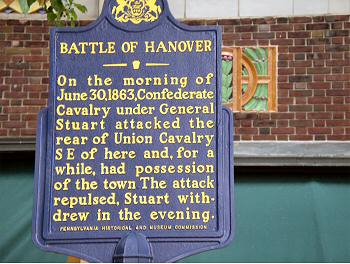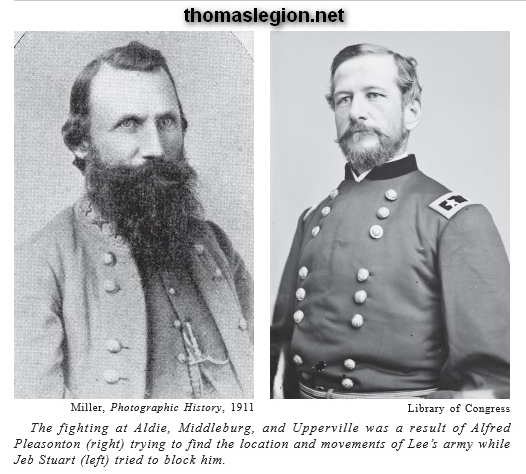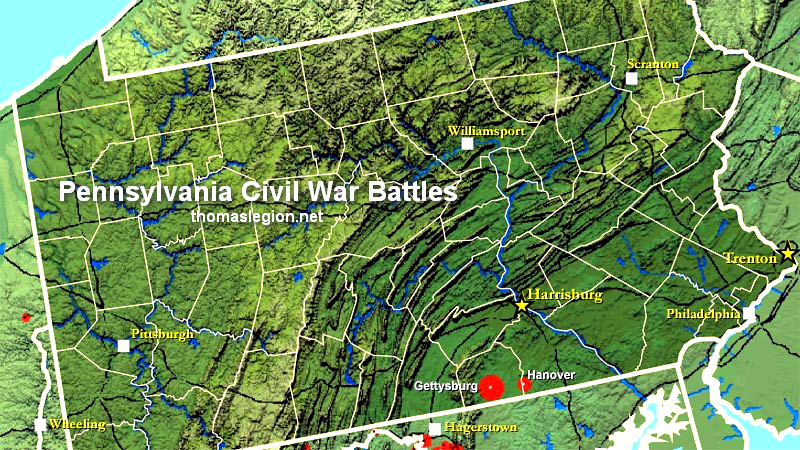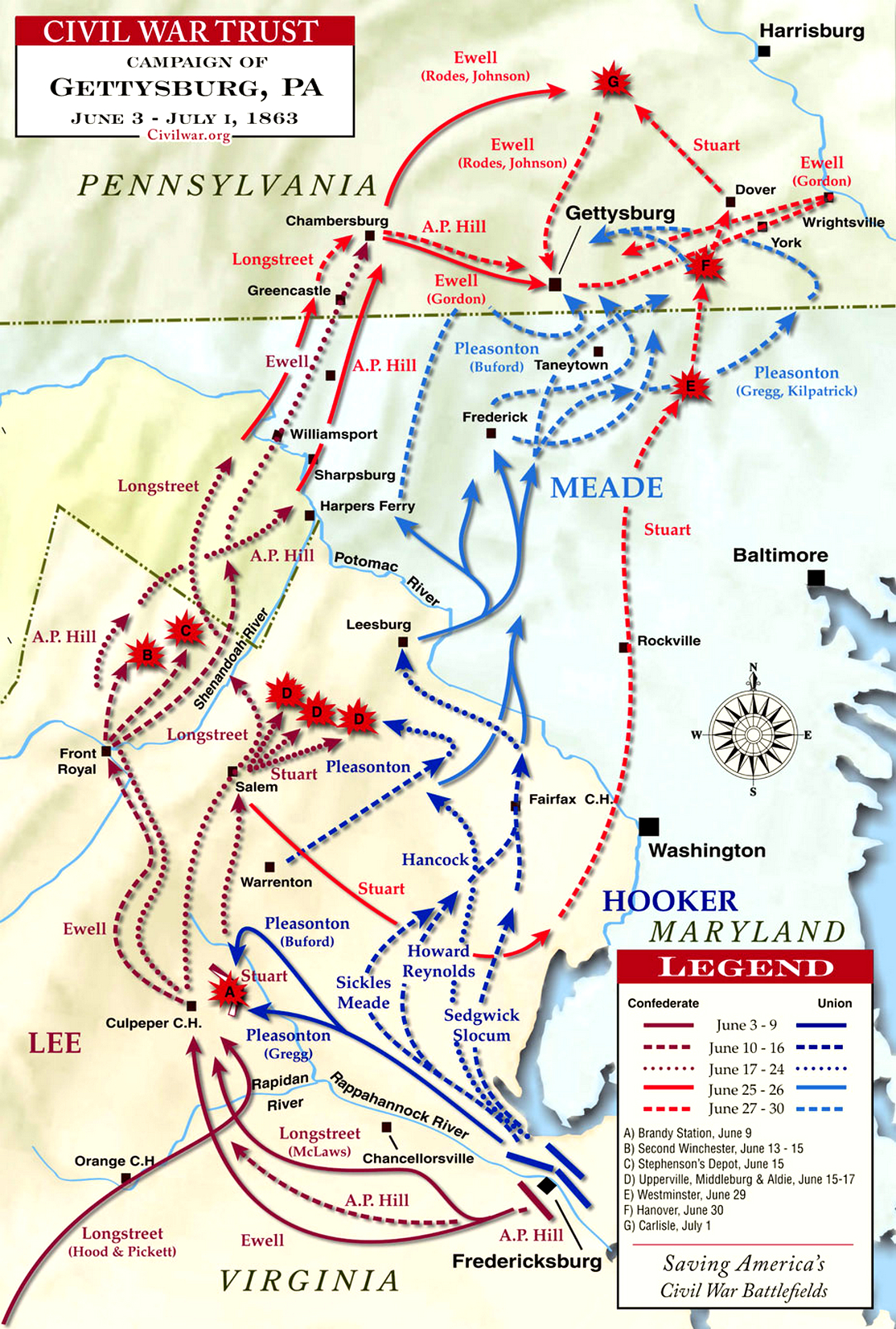|
Battle of Hanover
Hanover Civil War History
Battle of Hanover
Other Names: None
Location: York County
Campaign: Gettysburg Campaign (June-July 1863)
Date(s): June 30,
1863
Principal Commanders: Brig. Gen. H. Judson Kilpatrick [US]; Maj.
Gen. J.E.B. Stuart [CS]
Forces Engaged: Brigades
Estimated Casualties: 330 total
Result(s): Inconclusive
| Civil War Battle of Hanover Historical Marker |

|
| Civil War Battle of Hanover, Pennsylvania |
Introduction: Maj. Gen. J.E.B. Stuart’s cavalry, which was riding north to get around the
Union army, attacked a Union cavalry regiment, driving it through the streets of Hanover. Brig. Gen. Farnsworth's brigade arrived and counterattacked, routing the Confederate vanguard and nearly capturing Stuart himself. Stuart counterattacked.
Reinforced by Brig. Gen. George A. Custer’s brigade, Farnsworth held his ground, and a stalemate
ensued. Stuart was forced to continue north and east to get around the Union cavalry, further delaying his attempt to rejoin
Lee’s army which was then concentrating at Cashtown Gap west of Gettysburg.
| Battle of Hanover |

|
| (L) Stuart; (R) Pleasonton |
Background: As Robert E. Lee moved his Army of Northern
Virginia northward in June 1863 through the Shenandoah Valley towards Pennsylvania, portions of his cavalry under J.E.B. Stuart
slipped eastward across the path of the Union Army of the Potomac. A series of raids in eastern Maryland netted prisoners
and supplies, as well as disrupting Federal communications and telegraph lines. However, Stuart was not in position to effectively
screen Lee's advance or to provide intelligence on the movements of the Federal army. As Stuart headed north in an effort
to link with Lee, Union cavalry commander Maj. Gen. Alfred Pleasonton, riding towards Pennsylvania to the west of Stuart,
ordered his divisions to fan out across a wide swath, keeping an eye out for Confederates.
Brig. Gen. Judson Kilpatrick's division was on the Union right flank. The
majority of his men passed through Hanover early in the morning of June 30, pausing briefly for refreshments and to receive
the greetings of the jubilant townspeople. Their town had been raided three days before by Confederate Lt. Col. Elijah V.
White's cavalry, attached to Maj. Gen. Jubal Early's division that had occupied York County. White's Virginians and Marylanders
had followed the railroad to Hanover from nearby Gettysburg, and taken horses, food, supplies, clothing, shoes, and other
desired items from the townspeople, often paying with valueless Confederate money or drafts on the Confederate government.
White's raiders had destroyed the area's telegraph wires, cutting off communications with the outside world, before sacking
the nearby Hanover Junction train station. The unexpected arrival of Kilpatrick's column was a pleasant surprise to the residents
of Hanover, who warmly greeted the Union troopers with food and drink.
Most of Kilpatrick's men remounted and passed through town, heading northward
through the nearby Pigeon Hills towards Abbottstown. He left behind a small rear guard force to picket the roads south and
west of Hanover. In the meantime, Stuart had left his billet at Shriver's Corner, Maryland, and was proceeding northward across
the Mason–Dixon line into Pennsylvania. Hearing that Federal cavalry had been spotted near his intended destination,
Littlestown, Pennsylvania, he instead turned towards Hanover in adjacent York County. His progress was slowed considerably
by a cumbersome train of over 125 heavily laden supply wagons that he had captured near Rockville, Maryland. In addition,
he had skirmished with Delaware cavalry on June 29 at Westminster, Maryland, further delaying him.
Battle: Shortly before 10:00 a.m. on June 30, the
rear guard of the 18th Pennsylvania Cavalry encountered Confederate videttes about three miles southwest of Hanover at Gitt's
Mill. In the ensuing exchange of small arms fire, a Confederate cavalryman died and several were wounded. Shortly afterwards,
25 men from Company G of the 18th Pennsylvania were captured by the 13th Virginia from John R. Chambliss’s brigade,
the vanguard of Stuart's oncoming cavalry. Also that morning, a series of minor engagements occurred near Littlestown and
elsewhere along Stuart's path.
Southwest of Hanover at a tiny hamlet now known as Pennville, the 2nd North
Carolina Cavalry struck the 18th Pennsylvania’s main column and split it in two. Union survivors retired in disorder
through the streets of Hanover just as Stuart's horse artillery arrived, unlimbered, and opened fire. As the Confederates
occupied the town in the wake of the fleeing Pennsylvanians, General Farnsworth wheeled the 5th New York Cavalry into position
near the town commons and attacked the Rebel flank in the streets, forcing the Tar Heels to abandon their brief hold on the
town. The commander of the 2nd North Carolina, William Henry Fitzhugh Payne, was captured after his dying horse pitched him
into a nearby tanning vat. A Union soldier pulled Payne out and took him prisoner.
As more of Chambliss's men (and General Stuart) arrived on the scene, they
were met by additional Federals near the sprawling Karle Forney farm, just south of Hanover. Nearly surrounded in the confused
fighting, Stuart and a staff officer made their escape cross-country through the hedges bordering the country lane, at one
point leaping their horses over a 15-foot wide ditch. Hearing the unmistakable sound of distant gunfire, Judson Kilpatrick
raced southward towards Hanover, with his horse dying in the town square from the severe ride. The young general began to
deploy his men in and around Hanover, barricading some streets with barrels, farm wagons, dry goods boxes, and anything else
that might provide cover. Shortly before noon, fighting at the Forney farm ceased as the Rebels broke off contact. Kilpatrick
positioned Custer's newly arrived brigade on the farm and awaited developments.
| Pennsylvania Civil War battles |

|
| Battle of Hanover |
When Fitzhugh Lee's Virginia brigade arrived, Stuart moved his and Chambliss's
men into a new position on a ridge extending from the Keller Farm southwest of Hanover to Mount Olivet Cemetery southeast
of town. Meantime, Kilpatrick repositioned the brigades of the newly promoted duo of Custer and Farnsworth to form a better
defensive perimeter and then brought up his guns.
Leaving the captured wagons two miles south of town under heavy guard, Wade
Hampton at 2 p.m. brought his brigade and Breathed's Battery into position near the Mount Olivet Cemetery on the extreme right
of Stuart's line. An artillery duel ensued for the better part of two hours as opposing cannons hurtled shells over the town.
Fragments blasted holes in several houses and narrowly missed killing Mrs. Henry Winebrenner and her daughter, who had just
left their balcony when a projectile came hurtling through the upstairs.
During the prolonged artillery exchange, Custer's dismounted 6th Michigan
moved forward to within 300 yards of Chambliss and the two guns supporting his line. Flanked and losing fifteen men as prisoners,
the Wolverines tried again and succeeded in securing the Littlestown-Frederick Road, opening a line of communication with
the Union XII Corps. Stuart and Kilpatrick made no further aggressive moves, and both sides initiated a series of skirmishes
and minor probing actions.
Aftermath: Disengaging slowly and protecting his
captured wagons, Stuart withdrew to the northeast through Jefferson towards York, known from recent newspapers to be the location
of Early's division. En route, Stuart heard at New Salem that Early's Division had recently left York and marched northwestward
through Dover. Stuart changed course and headed northward through the night on winding, hilly country roads, still trying
to locate Early or Lt. Gen. Richard S. Ewell, thinking the latter still to be towards the Susquehanna River.
The head of Stuart's seventeen-mile long column arrived in Dover at 2:00
a.m. on the morning of July 1, with the rear guard there by 8:00 a.m. Stuart learned that Early had passed through town and
was heading westward towards Shippensburg as the army concentrated. Stuart paroled over 200 Union prisoners and gave his troopers
a much needed six-hour rest (while, unknown to Stuart, Maj. Gen. Henry Heth's Confederate infantry division collided with
Brig. Gen. John Buford's Union cavalry at Gettysburg). Stuart resumed his exhausting march through the afternoon and early
evening, seizing over 1,000 fresh horses from York County farmers.
Leaving Hampton's Brigade and the wagons at Dillsburg, Stuart headed for
Carlisle, hoping to find Ewell. Instead, Stuart found nearly 3,000 Pennsylvania and New York militia occupying the borough.
After lobbing a few shells into town during the early evening and burning the Carlisle Barracks, Stuart withdrew after midnight
to the south towards Gettysburg. The fighting at Hanover, the long march through York County with the captured wagons, and
the brief encounter at Carlisle slowed Stuart considerably in his attempt to rejoin the main army and locate Lee. The "eyes
and ears" of the Army of Northern Virginia had failed Lee.
| Hanover Civil War Battle |

|
| Gettysburg Campaign |
Losses at Hanover were relatively light in terms of casualties, but the
cost in time in delaying Stuart from linking with Lee proved to be even more costly. Estimates vary as to the number of men
lost at Hanover; Union losses in one source are listed as 19 killed, 73 wounded, and 123 missing (for a total of 215). The
18th Pennsylvania had suffered the most, with three men killed, 24 wounded, and 57 missing. On the Confederate side, Stuart's
losses are generally estimated as 9 dead, 50 wounded, and 58 missing, for a total of 117.
Analysis: As Gen. Robert E. Lee moved his Army of Northern Virginia northward in June 1863
through the Shenandoah Valley towards Pennsylvania, portions of his cavalry under J.E.B. Stuart slipped eastward across the
path of the Union Army of the Potomac. A series of raids in eastern Maryland netted prisoners and supplies, as well as disrupting
Federal communications and telegraph lines. However, Stuart was not in position to effectively screen Lee's advance or to
provide intelligence on the movements of the Federal army. As Stuart headed north in an effort to link with Lee, Union cavalry
commander Maj. Gen. Alfred Pleasonton, riding towards Pennsylvania to the west of Stuart, ordered his divisions to fan out
across a wide swath, keeping an eye out for Confederates.
Brig. Gen. Judson Kilpatrick's division was on the Union right flank. The majority of his men passed through
Hanover early in the morning of June 30, pausing briefly for refreshments and to receive the greetings of the jubilant townspeople.
Their town had been raided three days before by Confederate Lt. Col. Elijah V. White's cavalry, attached to Maj. Gen. Jubal
Early's division that had occupied York County. White's Virginians and Marylanders had followed the railroad to Hanover from
nearby Gettysburg, and taken horses, food, supplies, clothing, shoes, and other desired items from the townspeople, often
paying with valueless Confederate money or drafts on the Confederate government. White's raiders had destroyed the area's
telegraph wires, cutting off communications with the outside world, before sacking the nearby Hanover Junction train station.
The unexpected arrival of Kilpatrick's column was a pleasant surprise to the residents of Hanover, who warmly greeted the
Union troopers with food and drink.
Most of Kilpatrick's men remounted and passed through town, heading northward through the nearby Pigeon
Hills towards Abbottstown. He left behind a small rear guard force to picket the roads south and west of Hanover. In the meantime,
Stuart had left his billet at Shriver's Corner, Maryland, and was proceeding northward across the Mason–Dixon line into
Pennsylvania. Hearing that Federal cavalry had been spotted near his intended destination, Littlestown, Pennsylvania, he instead
turned towards Hanover in adjacent York County. His progress was slowed considerably by a cumbersome train of over 125 heavily
laden supply wagons that he had captured near Rockville, Maryland. In addition, he had skirmished with Delaware cavalry on
June 29 at Westminster, Maryland, further delaying him.
Stuart reappeared at Carlisle on July 1, and with horse artillery he shelled the town before
moving his command toward the fighting at Gettysburg at 1 a.m. on July 2. Absent the "eyes and ears" of his army, Gen. Lee
was blind to the location and strength of Union forces while the ground of Gettysburg was being contested. Hanover
and Carlisle were two significant events during the Gettysburg Campaign, and if Lee had known the disposition of enemy troops
at the small town, he may have positioned his army differently, thus allowing another outcome of the three day engagement
that claimed some 51,000 casualties.
Sources: National Park Service; Civil War Trust, civilwar.org; Official
Records of the Union and Confederate Armies; Anthony, William. Anthony's History of the Battle of Hanover. Hanover, PA: Self-published,
1945; Encounter at Hanover: Prelude to Gettysburg. Gettysburg, PA: Historical Publication Committee of the Hanover Chamber
of Commerce, Times and News Publishing Company, 1962; Ferree, Barr, ed. 1906 Year Book of the Pennsylvania Society of New
York, New York City: The Pennsylvania Society, 1906; Krepps, John T. A Strong and Sudden Onslaught: The Cavalry Action at
Hanover, Pennsylvania. Ortana, PA: Colecraft Industries, 2008. ISBN 978-0-9777125-7-1; Rummel III, George. Cavalry of the
Roads to Gettysburg: Kilpatrick at Hanover and Hunterstown. Shippensburg, PA: White Mane Publishing Company, 2000. ISBN 1-57249-174-4;
Wittenberg, Eric J., and J. David Petruzzi. Plenty of Blame to Go Around: Jeb Stuart's Controversial Ride to Gettysburg. New
York: Savas Beatie, 2006. ISBN 1-932714-20-0.
|

